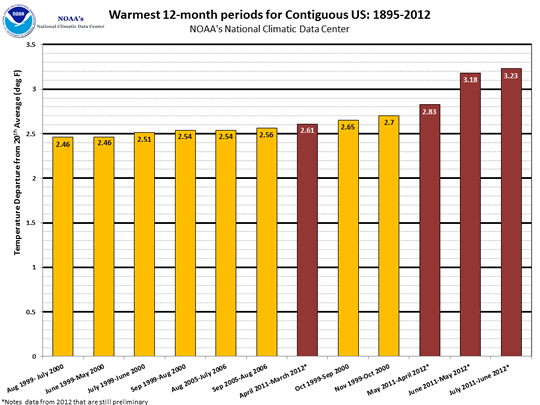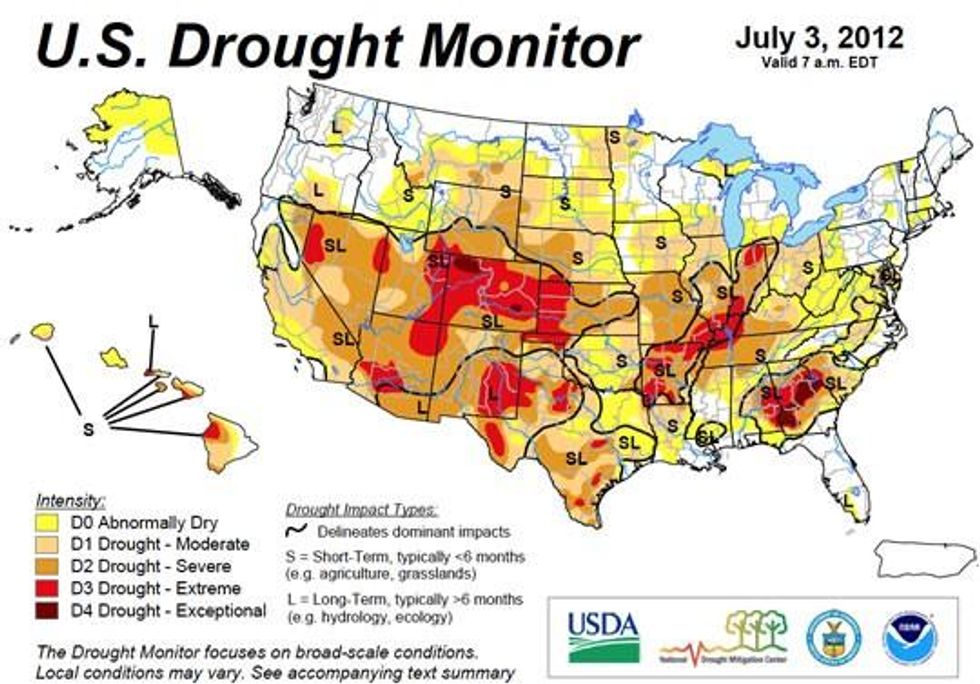US Has Warmest Year-to-Date As Drought Expands
Extreme weather turning the tide of opinion against climate change skeptics
The U.S. just recorded the warmest first half-year on record, according to statistics released Monday by the National Oceanic and Atmospheric Administration (NOAA). The national temperature of 52.9degF was 4.5degF above the 20th century average for the January-June period. Most of the contiguous U.S. was record and near-record warm for the six-month period.
At the end of the month, 56 percent of the country was experiencing drought conditions, which NOAA said was the largest drought footprint of the 21st century. The previous drought records occurred on Aug. 26, 2003, when 54.79 percent of the lower 48 were in drought and on Sept 10, 2002, when drought extended across 54.63 percent of this area.
Escalating bouts of extreme weather appear to be turning public opinion against global warming skeptics, according to Jane Lubchenco, the head of the NOAA.
"I think there really is a heightened awareness now, because it is something tangible, it's something people are experiencing themselves - more heatwaves, more wildfires... In the US, I think that the increasing number of extreme weather-related events will help the American public understand that there is a lot at risk and that we do need to be acting more definitively... The heatwaves that we have been seeing in the eastern United States are completely consistent with what we expected to be seeing, and we expect to see more."
* * *
Highlights from the NOAA report:
- According to the U.S. Drought Monitor, as of July 3, 56.0% of the contiguous U.S. experienced drought conditions, marking the largest percentage of the nation experiencing drought conditions in the 12-year record of the U.S. Drought Monitor. Drought conditions improved across Florida, due to the rains from Tropical Storm Debby. Drought conditions worsened across much of the West, Central Plains, and the Ohio Valley, causing significant impacts on agriculture in those regions.
- The July 2011-June 2012 period was the warmest 12-month period of any 12-months on record for the contiguous U.S., narrowly surpassing the record broken last month for the June 2011-May 2012 period by 0.05degF. The nationally-averaged temperature of 56.0degF was 3.2degF above the long term average. Every state across the contiguous U.S. had warmer than average temperatures for the period, except Washington, which was near normal.
- The first six months of 2012 were also drier than average for much of the contiguous U.S., with a nationally-averaged precipitation total 1.62 inches below average. Drier-than-average conditions stretched from the West, through the Central Plains, into the Ohio Valley and Mid-Atlantic. Fourteen states in total had precipitation totals for the six-month period among their ten driest.
- Record-breaking temperatures occurred across a large portion of the nation during the second half of June. Over 170 all-time warm temperature records were broken or tied during the month. Temperatures in South Carolina (113degF) and Georgia (112degF) are currently under review by the U.S. State Climate Extremes Committee as possible all-time statewide temperature records.
- The U.S. Climate Extremes Index (USCEI), an index that tracks the highest and lowest 10 percent of extremes in temperature, precipitation, drought and tropical cyclones across the contiguous U.S., was a record-large 44 percent during the January-June period, over twice the average value. Extremes in warm daytime temperatures (83 percent) and warm nighttime temperatures (70 percent) covered large areas of the nation, contributing to the record high value.
* * *

* * *

# # #
An Urgent Message From Our Co-Founder
Dear Common Dreams reader, The U.S. is on a fast track to authoritarianism like nothing I've ever seen. Meanwhile, corporate news outlets are utterly capitulating to Trump, twisting their coverage to avoid drawing his ire while lining up to stuff cash in his pockets. That's why I believe that Common Dreams is doing the best and most consequential reporting that we've ever done. Our small but mighty team is a progressive reporting powerhouse, covering the news every day that the corporate media never will. Our mission has always been simple: To inform. To inspire. And to ignite change for the common good. Now here's the key piece that I want all our readers to understand: None of this would be possible without your financial support. That's not just some fundraising cliche. It's the absolute and literal truth. We don't accept corporate advertising and never will. We don't have a paywall because we don't think people should be blocked from critical news based on their ability to pay. Everything we do is funded by the donations of readers like you. Will you donate now to help power the nonprofit, independent reporting of Common Dreams? Thank you for being a vital member of our community. Together, we can keep independent journalism alive when it’s needed most. - Craig Brown, Co-founder |
The U.S. just recorded the warmest first half-year on record, according to statistics released Monday by the National Oceanic and Atmospheric Administration (NOAA). The national temperature of 52.9degF was 4.5degF above the 20th century average for the January-June period. Most of the contiguous U.S. was record and near-record warm for the six-month period.
At the end of the month, 56 percent of the country was experiencing drought conditions, which NOAA said was the largest drought footprint of the 21st century. The previous drought records occurred on Aug. 26, 2003, when 54.79 percent of the lower 48 were in drought and on Sept 10, 2002, when drought extended across 54.63 percent of this area.
Escalating bouts of extreme weather appear to be turning public opinion against global warming skeptics, according to Jane Lubchenco, the head of the NOAA.
"I think there really is a heightened awareness now, because it is something tangible, it's something people are experiencing themselves - more heatwaves, more wildfires... In the US, I think that the increasing number of extreme weather-related events will help the American public understand that there is a lot at risk and that we do need to be acting more definitively... The heatwaves that we have been seeing in the eastern United States are completely consistent with what we expected to be seeing, and we expect to see more."
* * *
Highlights from the NOAA report:
- According to the U.S. Drought Monitor, as of July 3, 56.0% of the contiguous U.S. experienced drought conditions, marking the largest percentage of the nation experiencing drought conditions in the 12-year record of the U.S. Drought Monitor. Drought conditions improved across Florida, due to the rains from Tropical Storm Debby. Drought conditions worsened across much of the West, Central Plains, and the Ohio Valley, causing significant impacts on agriculture in those regions.
- The July 2011-June 2012 period was the warmest 12-month period of any 12-months on record for the contiguous U.S., narrowly surpassing the record broken last month for the June 2011-May 2012 period by 0.05degF. The nationally-averaged temperature of 56.0degF was 3.2degF above the long term average. Every state across the contiguous U.S. had warmer than average temperatures for the period, except Washington, which was near normal.
- The first six months of 2012 were also drier than average for much of the contiguous U.S., with a nationally-averaged precipitation total 1.62 inches below average. Drier-than-average conditions stretched from the West, through the Central Plains, into the Ohio Valley and Mid-Atlantic. Fourteen states in total had precipitation totals for the six-month period among their ten driest.
- Record-breaking temperatures occurred across a large portion of the nation during the second half of June. Over 170 all-time warm temperature records were broken or tied during the month. Temperatures in South Carolina (113degF) and Georgia (112degF) are currently under review by the U.S. State Climate Extremes Committee as possible all-time statewide temperature records.
- The U.S. Climate Extremes Index (USCEI), an index that tracks the highest and lowest 10 percent of extremes in temperature, precipitation, drought and tropical cyclones across the contiguous U.S., was a record-large 44 percent during the January-June period, over twice the average value. Extremes in warm daytime temperatures (83 percent) and warm nighttime temperatures (70 percent) covered large areas of the nation, contributing to the record high value.
* * *

* * *

# # #
The U.S. just recorded the warmest first half-year on record, according to statistics released Monday by the National Oceanic and Atmospheric Administration (NOAA). The national temperature of 52.9degF was 4.5degF above the 20th century average for the January-June period. Most of the contiguous U.S. was record and near-record warm for the six-month period.
At the end of the month, 56 percent of the country was experiencing drought conditions, which NOAA said was the largest drought footprint of the 21st century. The previous drought records occurred on Aug. 26, 2003, when 54.79 percent of the lower 48 were in drought and on Sept 10, 2002, when drought extended across 54.63 percent of this area.
Escalating bouts of extreme weather appear to be turning public opinion against global warming skeptics, according to Jane Lubchenco, the head of the NOAA.
"I think there really is a heightened awareness now, because it is something tangible, it's something people are experiencing themselves - more heatwaves, more wildfires... In the US, I think that the increasing number of extreme weather-related events will help the American public understand that there is a lot at risk and that we do need to be acting more definitively... The heatwaves that we have been seeing in the eastern United States are completely consistent with what we expected to be seeing, and we expect to see more."
* * *
Highlights from the NOAA report:
- According to the U.S. Drought Monitor, as of July 3, 56.0% of the contiguous U.S. experienced drought conditions, marking the largest percentage of the nation experiencing drought conditions in the 12-year record of the U.S. Drought Monitor. Drought conditions improved across Florida, due to the rains from Tropical Storm Debby. Drought conditions worsened across much of the West, Central Plains, and the Ohio Valley, causing significant impacts on agriculture in those regions.
- The July 2011-June 2012 period was the warmest 12-month period of any 12-months on record for the contiguous U.S., narrowly surpassing the record broken last month for the June 2011-May 2012 period by 0.05degF. The nationally-averaged temperature of 56.0degF was 3.2degF above the long term average. Every state across the contiguous U.S. had warmer than average temperatures for the period, except Washington, which was near normal.
- The first six months of 2012 were also drier than average for much of the contiguous U.S., with a nationally-averaged precipitation total 1.62 inches below average. Drier-than-average conditions stretched from the West, through the Central Plains, into the Ohio Valley and Mid-Atlantic. Fourteen states in total had precipitation totals for the six-month period among their ten driest.
- Record-breaking temperatures occurred across a large portion of the nation during the second half of June. Over 170 all-time warm temperature records were broken or tied during the month. Temperatures in South Carolina (113degF) and Georgia (112degF) are currently under review by the U.S. State Climate Extremes Committee as possible all-time statewide temperature records.
- The U.S. Climate Extremes Index (USCEI), an index that tracks the highest and lowest 10 percent of extremes in temperature, precipitation, drought and tropical cyclones across the contiguous U.S., was a record-large 44 percent during the January-June period, over twice the average value. Extremes in warm daytime temperatures (83 percent) and warm nighttime temperatures (70 percent) covered large areas of the nation, contributing to the record high value.
* * *

* * *

# # #

